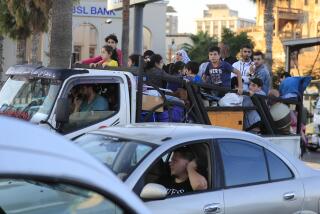Displaced Afghans fret in a cold, cramped limbo
- Share via
KABUL, AFGHANISTAN — In wind-whipped tents, makeshift shelters and overcrowded family compounds, Afghans who fled the battleground town of Marja are asking themselves and one another: When will it be safe to go home?
Since the start this month of a massive assault by U.S. Marines and British and Afghan troops on the southern Afghan town, nearly 4,000 families have sought shelter in nearby Lashkar Gah, the capital of Helmand province. By the calculation generally used by aid agencies -- six people per family, though many are far larger -- that would add up to at least 24,000 people, nearly one-third of the town’s population.
The figure takes into account only those who have officially registered as displaced; thousands of others are thought to be undocumented. Many fled with only scant possessions, hoping the fighting that erupted Feb. 13 would end quickly.
“People want to find a way to go back,” said Ghulam Farooq Norzai, who heads of the directorate of displaced people in Helmand province. “They left everything behind: homes, livestock, farms.”
The Western military says residents are beginning to trickle home, which it counts as a vote of confidence in the government’s pledge to establish rule of law and restore long-vanished public services in the town, which was for years a Taliban haven.
But many of the Marja refugees are hesitating, fearful of roadside bombs, Taliban stragglers and continuing battles between insurgents and coalition troops.
“People were very hopeful at first; they thought the offensive would take a few days,” said Mohammed Anwar, whose 15-member clan is sharing a cold, cramped house in Lashkar Gah with four other displaced families. “But there is no hope of going back until one side or the other is in complete control.”
The clashes have steadily diminished, though firefights still flare and tracts of the town remain minefields. On Wednesday, the North Atlantic Treaty Organization reported fewer engagements with insurgents over the previous 24 hours. But commanders have said that clearing operations could take another month.
For agricultural families, the great majority of the town’s residents, each passing day is a countdown to ruin. Worry beads click as farmers envision their crops dying, livestock scattered or starving, irrigation ditches choked with debris.
Still, many believe their decision to flee may have saved their lives. NATO says 16 civilians have been killed in the offensive, but the Afghanistan Human Rights Commission on Wednesday put the civilian death toll at 28, of whom 13 were children. At least 70 people have been hurt, the group said.
Although most of the displaced have access to food and at least rudimentary shelter, the privations are beginning to grate. Kinship dictates that a family must take in fleeing relatives without question. But many people in rural Helmand already live at the subsistence level, so host families and their guests alike face growing hardship.
“Most people find relatives who can at least give them one room to share, but it’s hard for both families,” said Mohammad Hussain Haider, who fled Marja with his wife and five children. “It’s winter, and people ran away without warm clothing and other necessary things.”
Afghan officials expect the refugee exodus to reverse, but do not know when.
“If there were no threat, people would go home immediately,” said Norzai. “But it will take time.”
--
Special correspondent Aimal Yaqubi contributed to this report.
More to Read
Sign up for Essential California
The most important California stories and recommendations in your inbox every morning.
You may occasionally receive promotional content from the Los Angeles Times.










